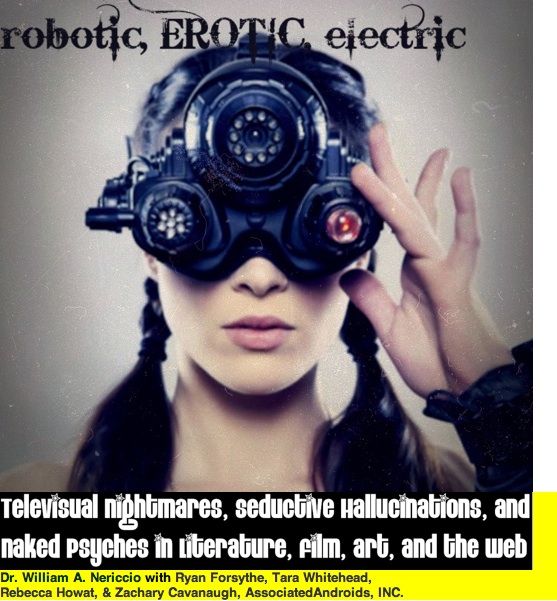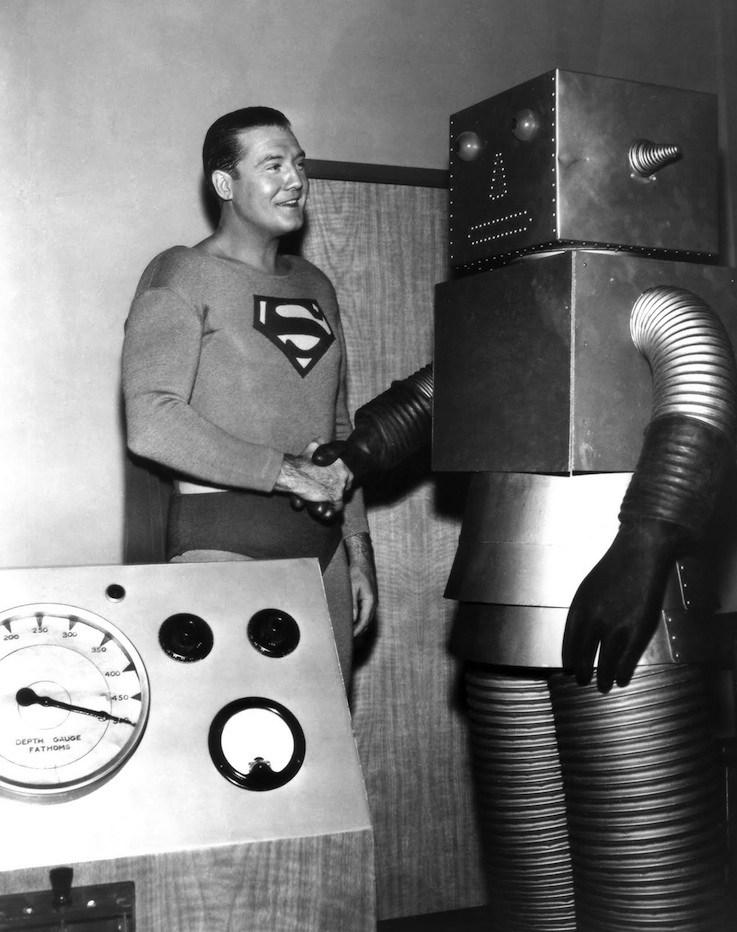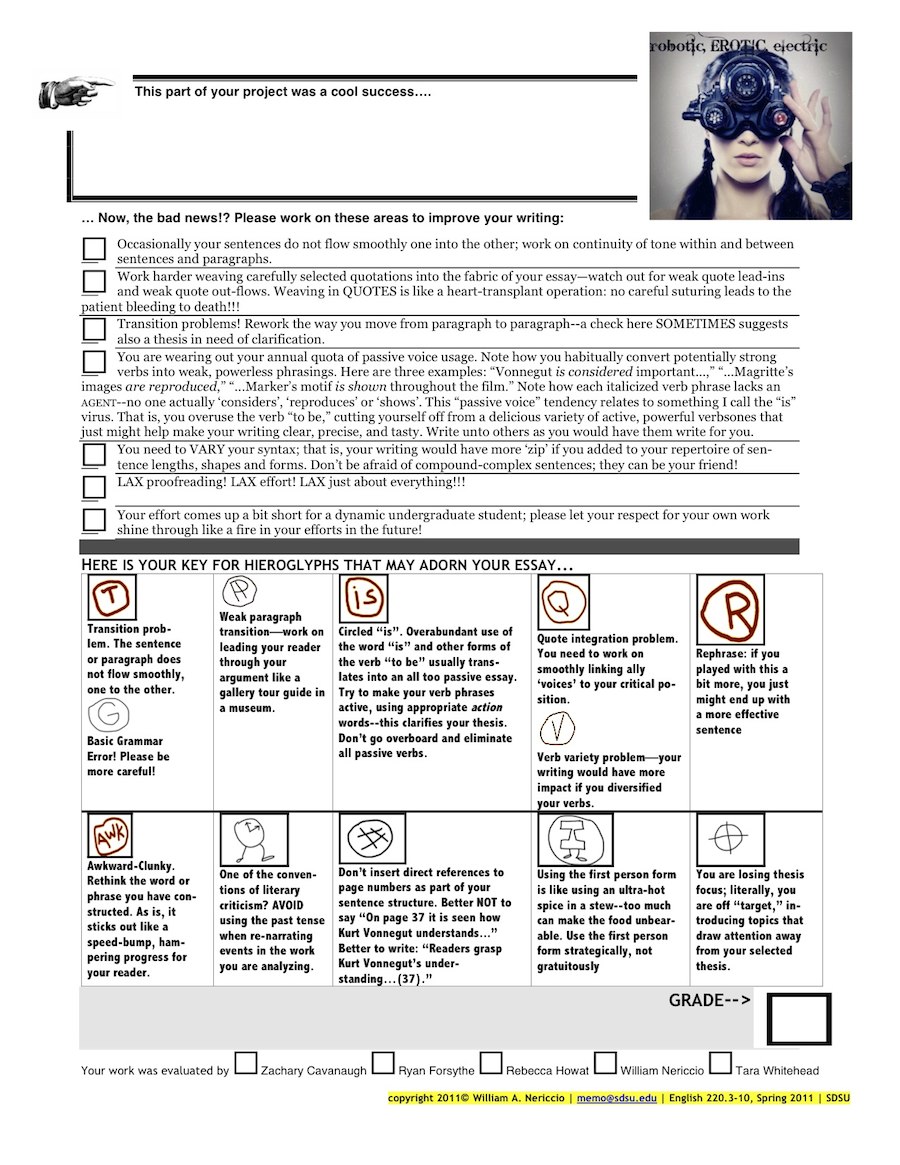 |
| Engl 220.3-220.10 | Spring 2011 | W. Nericcio & Company |
urgent issues? email: memo@sdsu.edu | phone: 619.594.1524 Elegant, eclectic, and clever (not to mention an American original when it comes to writing), Gore Vidal reminds young writers that a peek into the fabulous history of the word essay, an etymological poke into the labyrinth of essay's past, reveals other words you might not have expected to run across: "trying," "testing," and "rehears[ing]." You see most people think of an essay as a finished product--a dull, lifeless, inert textual body with a static introduction, an "ABCD" body, and a clear lets-tie-up-all-the-pieces conclusion. You will not write this kind of essay, opting instead to produce something that is less product and more process, less finished, museum-bound artifact, and more beautiful symphony. Allow the OED, the Oxford English Dictionary to show you the "guts," the DNA of the term "essay," with its Jeckyll/Hyde twin, "assay": [a. OF. essai, essay: see ASSAY n. For several of the senses see also SAY.
In 18th c. the accent. was sometimes on the 2nd syll.] I. The action or process of trying or testing. 1. A trial, testing, proof; experiment; = ASSAY n. 1, 3. Obs. c1600 SHAKES. Sonn. cx, Worse essays proved thee my best of love. 1605 BACON Adv. Learn. II. vii. §7 Democritus..attributed the form thereof [of the ‘frame of things’] able to maintain itself to infinite essaies or proofs of nature. 1631 HEYLIN St. George 247, I will make bold to venture on it, by way of tryall and essay. 1648 Eikon Bas. 26 It was the first overt Essay to be made, how patiently I could bear the loss of my kingdoms. 1660 SHARROCK Vegetables Ep. Ded., You were pleased to judge me able, and..to propose..that I should make an essay of that ability. 1704 ADDISON Italy (1733) 195 After having made Essays into it, as they do for Coal in England. 1745 De Foe's Eng. Tradesman I. xii. 98 He has made an essay by which he knows what he can, and cannot do. 1812 J. HENRY Camp. agst. Quebec 28 From the essays made, it seemed to me that, etc. b. spec. The trial of metals; = ASSAY 6. Obs.
So,
for the purposes of this writing/research challenge, I am asking for you to return to the origins of the essay. Your
mandated task is to make a sincere attempt (a trying, a testing, a rehearsing) to produce a set of ordered
reflections, a group of carefully arranged tasty words that respond in
some way to the novels, films, art, cultural criticism, and lectures you
have worked through and will continue to work through in the coming weeks.
Are you writing for your professor and your talented quartet of GTAs? In a way, of course
you are. But
in order to do well on this assignment, you must forget about your peculiar guide--the
only people who count are the readers you write for: the audience for your
paper.
Who are they? Well, they are a lot like you. They are impatient and easily bored. They like specific details; they love direct, succinct quotes woven carefully into the fabric of an essay. If you are going to write about an image, they want to see a xeroxed reproduction of that image properly captioned and carefully catalogued in your list of works cited. They hate misspellings and passive verbs. They like tangy language which is fresh and not filled with predictable clichés. Specifications, you ask? Here they are: Your
essays will run anywhere from 3 to 5 pages
(tops). At the top of the first page, above your title, you will write out the prompt to which you are responding. Your essay will be cleverly titled, double-spaced, have 1-inch margins
top and sides and be carefully
proofread; additionally, it will be chock-full of active verbs and, in
general, have syntactic variety so as to avoid the dangers of the IS
VIRUS; use MLA or University of Chicago-style works cited pages. Your works of genius are
due Wednesday, February 23, 2010 in class--you will walk into class on
time and drop your paper into the decorated receptacle that corresponds
to your specific section (there will be one other bag with my name on
it as well). All A-level critical speculations will integrate carefully selected direct quotations from the primary texts and will avoid ALL of the quicksand-like bad habits noted here on the gradesheet to your right--click it to make it readable. gradesheet. One last bit of advice, do NOT plagiarize ANY material from the internet; unCITED material = PLAGIARISM; also, if you are going to "quote" a passage from an illustrated text, go to the bother of xeroxing the image and incorporating it INTO your essay. Last hint? Have a blast with this paper! Try things you have NEVER tried before! Test the limits of your imagination! Especially for graduating seniors: put everything you know on and between the lines of your big scary imagination blow-out! Good luck: with your talents, you may not need it! Choose ONE of the following prompts... 1. THE SABOTAGE OF CONVENTION Both Kurt
Vonnegut and René Magritte break convention to create their art.
Vonnegut eschews the traditional means of storytelling by placing
himself into the text, evoking the meta-textual, and humorously
criticizing American Society. While Magritte breaks away from the
conventions of established art with his ludic or playful and Surrealist
images. Would either of these artists have been as remarkable if they
had not deviated from the standard? Explore particular aspects each of
these artists employed that either worked especially well in the
creation of an amazing end product or hindered readers/viewers' larger
appreciation of their work. 2. HOLY SHIT! THEY ARE IN THE TEXT!!! Both Vonnegut
and Magritte have interesting personal histories that can be
interpreted as largely impacting upon their work--investigate the
detriments and benefits of interpreting the artist's personal history
in their art. Note this work must be carefully researched (information
cut and pasted from wikipedia ain't gonna cut it!) 3. OHHHHHHH--TWINSIES... In Breakfast of Champions and Dr. Jekyll and Mr. Hyde
we can observe several instances of characters that are connected to
each other. Besides the obvious Dr.Jekyll and Mr. Hyde, the narrator
and Kilgore Trout share an intimate connection as do Kilgore Trout and
Dwayne Hoover. Explore the function and meaning of some of these
character pairs in both texts, or explore other character pairs in the
two texts that seem to respond to each other across the two texts. 4. THE PERSONAL IS POLITICAL Using the chapter "Autopsy of a Rat" in Dr. Nericcio's Tex[t]-Mex, analyze one or two specific instances of Vonnegut's social criticism in BOC. Remember that in order to do this you must first identify a specific criticism, identify why it works in the text as a social criticism, and then how Dr. Nericcio's text helps further elucidate this criticism. See what you're doing here? It's like the books are talking to one another! Magic! 5. LET'S TALK ABOUT LANGUAGE What materials
comprise the nucleus of a poem, novel, painting—any work of art?
What nerve system do these constructions possess? What blueprint do
they use to communicate ideas and convictions and confessions or
objections about the world at large? Language! ¶ Using Jacques
Meuris’ biography of the life and art of realist/surrealist
painter Rene Magritte [pub. Taschen] and Kurt Vonnegut’s Breakfast of Champions or Goodbye Blue Monday,
examine how reconstructed ideas of language and logic serve to
“mobilize the sub-conscious via the bias of the pre-conscious,
and in turn the bias of the obvious” (Meuris, 45). Hint: consider
the healthy abundance of stereotypes as well as Western culture’s
(unanimous) agreement on the low intrinsic value of things. 6. ALIENATION, ALIENATION What is the function of alienation in art? To what extent do Vonnegut and Magritte alienate their audiences, and for what purpose? Examine the technical strategies both artists use and note the similarities/differences in their approach. 7. CONDRADICTING CONTRADICTIONS Several of our texts present contradictions: Breakfast of Champions as simultaneously a realist text and an absurdist satire, both a comic and tragic text; Magritte simultaneously as both realist and surrealist; La Jettée as both film (moving pictures?) and static images. Using three of our "texts" so far (Vonnegut, Meuris, Nericcio, Marker, Stevenson, maybe Kafka), explore the notion of author/artist creating a work that contradicts itself. 8. I TAKE DRUGS THEREFORE I AM Though The Strange Case of Dr. Jekyll & Mr. Hyde often may seem a light-hearted tale, Stevenson makes an indictment of Victorian society. Similarly, Breakfast of Champions is at times quite playful, though it too condemns the values of the society represented. Interestingly, in both books, the use (or abuse) of chemicals causes characters to behave in different ways. Examine these two books and one other work, exploring the view each presents of humanity and society, and noting the role and purpose of induced items such as potions or chemicals (or time travel?) in attaining each view. 9. BEWARE! BEWARE! Both Vonnegut
and Magritte work to critique the artistic medium that they work within
in an attempt to influence the way people consume art and
literature. While Vonnegut warns his reader about the
seductiveness of stories, Magritte is concerned with the “tyranny
of images. “ Compare and contrast the ways in which both
men use their art to explore the problem of artistic represention,
providing specific examples from Breakfast of Champions and the Meuris' Taschen art book. 10. I BET YOU THINK YOU'VE SEEN THIS BEFORE Both Vonnegut and Magritte try to distance us from the everyday things, practices, and ideas that we tend to take for granted. While Vonnegut explores various aspects of American culture as if he were encountering them for the first time, making them seem ridiculous or arbitrary, Magritte paints ordinary objects and people in unusual juxtapositions to thwart our expectations and preconceived notions of art. Explore the ways in which Vonnegut and Magritte attempt to make us see ordinary ideas and things in a new light, providing specific examples from their work. 11. FUTURE SEMIOTICS FETISHISTS OF THE FUTURE, UNITE To be sure, Chris Marker's La Jettée helped change the future of art film in Europe and the United States--to document this, with this prompt, you will visit Love Library and find (and read) a chapter on Chris Marker to supplement your understanding. Your essay challenge in this question is as follows (it is designed especially for those of you considering a career in film, tv, and the visual arts): Contrast Marker's narrative style/technique with one other director of contemporary film..... either Darren Aronofsky, Black Swan; Christopher Nolan, Inception; Debra Granik, Winter's Bone. This is probably the toughest of all the prompts as it requires you to screen these Academy Award nominees anew AND to do secondary source research in Love Library. That said, for film geeks, this is the way to go! 12. Robotic Erotic Electric, ENOUGH ALREADY While
"Robotic, Erotic, Electric" is a catchy enough name for our English 220
seminar, a careful reading of the texts we have surveyed in class thus
far this semester would be equally well-served if we had entitled this
class _______________________________. Write an essay using close
reading and specific examples (word and image) to make the case for a
different way of thematically organizing this class. 13. ROLL YOUR OWN Develop and refine your OWN independent thesis; you MUST bring your proposal to me by Wednesday, February 16nth, in class (typed, please). You are also welcome to run it by me in person during office hours or by appointment--ON or BEFORE February 16, 2010. |

